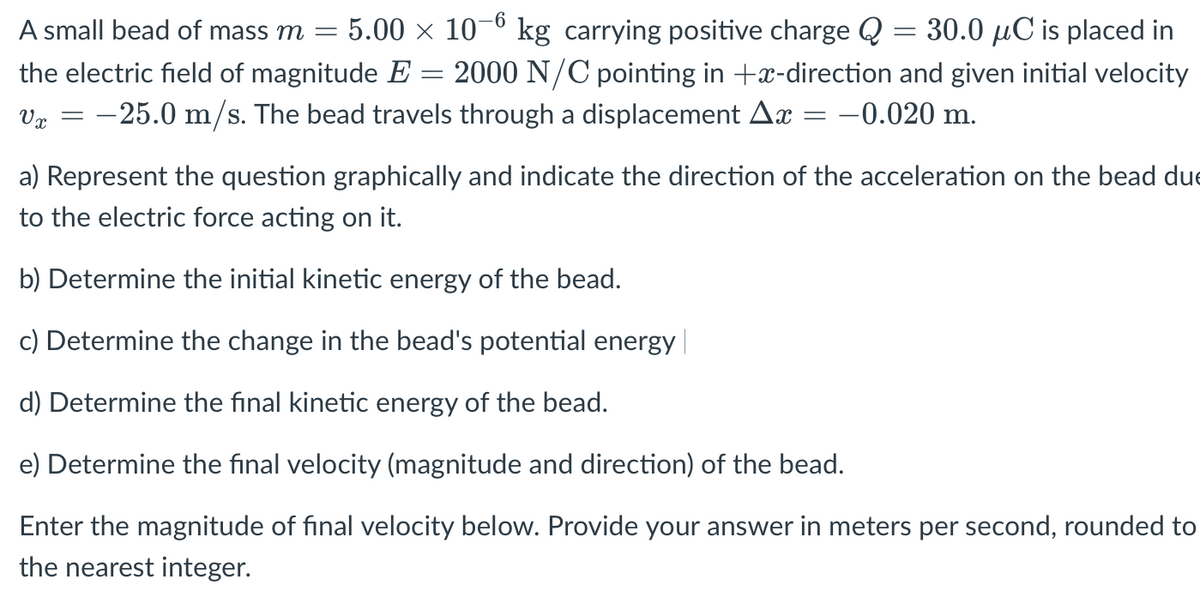A small bead of mass m = 5.00 × 10-º kg carrying positive charge Q = 30.0 µC is pl the electric field of magnitude E = 2000 N/C pointing in +x-direction and given initial Vz = -25.0 m/s. The bead travels through a displacement Ax %3D -0.020 m. a) Represent the question graphically and indicate the direction of the acceleration on the to the electric force acting on it. b) Determine the initial kinetic energy of the bead.
A small bead of mass m = 5.00 × 10-º kg carrying positive charge Q = 30.0 µC is pl the electric field of magnitude E = 2000 N/C pointing in +x-direction and given initial Vz = -25.0 m/s. The bead travels through a displacement Ax %3D -0.020 m. a) Represent the question graphically and indicate the direction of the acceleration on the to the electric force acting on it. b) Determine the initial kinetic energy of the bead.
College Physics
1st Edition
ISBN:9781938168000
Author:Paul Peter Urone, Roger Hinrichs
Publisher:Paul Peter Urone, Roger Hinrichs
Chapter18: Electric Charge And Electric Field
Section: Chapter Questions
Problem 58PE: Integrated Concepts An electron has an initial velocity of 5.00106m/s in a uniform 2.00105N/C...
Related questions
Question
100%
i need question a,b,c. thanks :)

Transcribed Image Text:5.00 x 10–6
kg carrying positive charge Q = 30.0 µC is placed in
2000 N/C pointing in +x-direction and given initial velocity
A small bead of mass m =
the electric field of magnitude E
Vz = -25.0 m/s. The bead travels through a displacement Ax = -0.020 m.
a) Represent the question graphically and indicate the direction of the acceleration on the bead due
to the electric force acting on it.
b) Determine the initial kinetic energy of the bead.
c) Determine the change in the bead's potential energy
d) Determine the final kinetic energy of the bead.
e) Determine the final velocity (magnitude and direction) of the bead.
Enter the magnitude of final velocity below. Provide your answer in meters per second, rounded to
the nearest integer.
Expert Solution
This question has been solved!
Explore an expertly crafted, step-by-step solution for a thorough understanding of key concepts.
Step by step
Solved in 3 steps with 2 images

Knowledge Booster
Learn more about
Need a deep-dive on the concept behind this application? Look no further. Learn more about this topic, physics and related others by exploring similar questions and additional content below.Recommended textbooks for you

College Physics
Physics
ISBN:
9781938168000
Author:
Paul Peter Urone, Roger Hinrichs
Publisher:
OpenStax College

College Physics
Physics
ISBN:
9781285737027
Author:
Raymond A. Serway, Chris Vuille
Publisher:
Cengage Learning

Physics for Scientists and Engineers, Technology …
Physics
ISBN:
9781305116399
Author:
Raymond A. Serway, John W. Jewett
Publisher:
Cengage Learning

College Physics
Physics
ISBN:
9781938168000
Author:
Paul Peter Urone, Roger Hinrichs
Publisher:
OpenStax College

College Physics
Physics
ISBN:
9781285737027
Author:
Raymond A. Serway, Chris Vuille
Publisher:
Cengage Learning

Physics for Scientists and Engineers, Technology …
Physics
ISBN:
9781305116399
Author:
Raymond A. Serway, John W. Jewett
Publisher:
Cengage Learning

College Physics
Physics
ISBN:
9781305952300
Author:
Raymond A. Serway, Chris Vuille
Publisher:
Cengage Learning

Principles of Physics: A Calculus-Based Text
Physics
ISBN:
9781133104261
Author:
Raymond A. Serway, John W. Jewett
Publisher:
Cengage Learning
